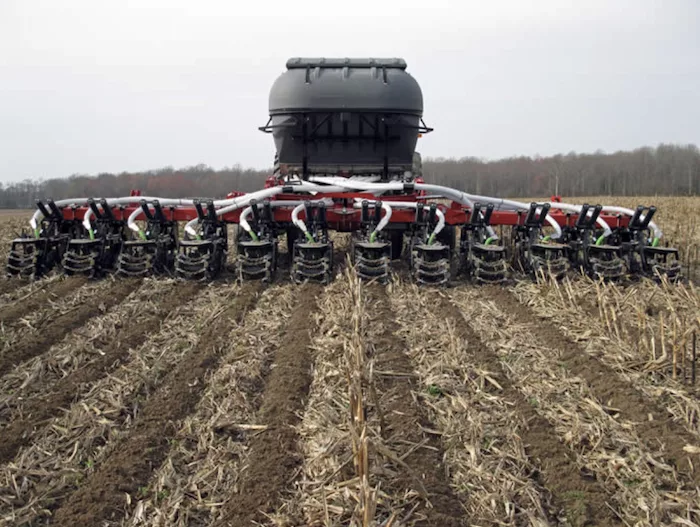Wanatah, Ind., strip-tiller Jeff Herrold provides a planting season update in the video below. Herrold, who's currently making strips between cereal rye and applying dry fertilizer, says he's ahead of schedule so far and will wrap up planting in the new few days. Herrold also previews his upcoming presentation at the 2025 National Strip-Tillage Conference, "Strip-Till Strategies for Increasing Nutrient Use Efficiency."
#PLANT25: Jeff Herrold checks in from Wanatah, Ind., where he’s strip-tilling between cereal rye & applying dry fertilizer. Herrold also previews his upcoming presentation at the National Strip-Till Conference, July 31 in Iowa City.
— Strip-Till Farmer (@StripTillFarmr) May 5, 2025
➡️ https://t.co/2gJn5lQyMB for more info! pic.twitter.com/adzkLbJfKb
Herrold, who strip-tills 3,500 acres of corn with his brother, Paul, learned a lot about nutrient uptake efficiency from a 70-acre test plot in 2017. The total program included around 250 pounds of nitrogen (N), 75 pounds of phosphorus (P), 80 pounds of potassium (K) and 55 pounds of sulfur. The field produced an average yield of 275 bushels per acre with some spots breaking the 300-bushel barrier.
“It excited me because we didn’t throw a bunch of N out there, and it was corn-on-corn,” Herrold says. “It was less than a pound of N per bushel.”
He has since become a firm believer in the benefits of spacing out fertilizer applications and dialing back N rates, rather than applying everything up front. Herrold’s gameplan calls for 4 different applications throughout the growing season — pre-plant, at plant, sidedress and during irrigation.
“The cation-exchange capacity (CEC) values in our sandy soils are between 6 and 8, which means they don’t have a ton of holding capacity,” Herrold says. “We apply nutrients at 4 different times because our soils can’t handle a lot at once.”
Spring Strip-Till
Efficiency is the name of the game for Herrold, who started strip-tilling in 2012 after growing tired of burning fuel, hours and dollars with full tillage on his 1,400 corn acres.
“We also liked the nutrient placement with strip-till,” he recalls. “Being able to place nutrients below the seed allowed us to become more efficient with our fertilizer.”
Herrold prefers making strips in the spring because he’s afraid of losing potash over the winter in his low CEC soils. And although he’s happy with his Dawn Pluribus coulter machine, he’s still wrestling with whether it’s better than a knife setup.
“We started with a Kuhn Krause Gladiator knife machine,” Herrold says. “We really liked it, but I think it would’ve been better for the fall than the spring. It seemed like we were doing a little too much tillage with it, and we didn’t need to be that aggressive. But I’m toying around with the idea of going back to a knife. We’re not getting the compaction taken out with the coulter, and it has me wondering if we should use a knife to go deeper. Right now, I’m basically in-line ripping in the fall, then making strips in the spring to take the deep compaction out. It’s not something I want to be doing, but it’s definitely necessary.”
First Applications
Herrold’s nutrient application marathon begins in the spring with his 12-row Dawn Pluribus V strip-till machine with a one-bin Salford tank attached. He makes strips 4-5 inches deep, applying a mix of 50 pounds of potash, 50 pounds of urea, 50 pounds of Mosaic MicroEssentials MES10 and 20 pounds of pelletized lime.
He makes application number 2 when planting corn with his 16-row John Deere planter — a 2-by-2 in-furrow starter fertilizer mix containing 9 gallons of 10-34-0, 8 gallons of 32% N, 1½ gallons of ammonium thiosulfate (ATS) as well as a micronutrient blend containing zinc, manganese, copper, boron and calcium.
“Any time we’re applying N, we apply sulfur as well because it helps with N uptake,” Herrold says. “Our soils are low on boron, zinc and sulfur. We apply about 1 gallon of zinc in furrow. It’s extremely hard to keep the boron levels up in our tissue samples, so I can’t do it in just one shot. I’m blessed with high P levels, but I have to get it into a form that’s available to me, and using zinc helps accomplish that.”
In-Season Applications
Herrold uses a Blu-Jet sidedress applicator with Y-drops for his third application around V4-V6. He applies about 30 gallons of 32%, 3¾ gallons of ATS, 4 gallons of K13, 1 quart of boron and 1 gallon of humates.
Herrold makes one final N application around tassel through an irrigation pivot, injecting 5-10 gallons of 32%. He adjusts the rates based on the condition of the crop and if he thinks it can reach the yield goal.
“By spacing out our applications, it’s saved us money on N and increased our overall efficiency,” Herrold says. “Our farm averaged about 236 bushels per acre in 2023, and we used about 190 N units across the entire program to achieve that. But we made the mistake of backing off our rates too much in 2023 because it was dry, and the crop didn’t look good in June. It turned out to be a really good corn crop, and we could have had higher yields if we didn’t hold some fertilizer back. It was a good learning experience and something I’ll keep in mind moving forward.”







